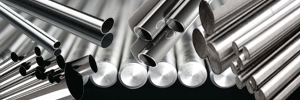
 |
Austenitic | Martensitic | Ferritic | Duplex | Super Duplex | Superaustenitic | Superferritic | Precipitation Hardening In metallurgy, stainless steel, also known as inox steel or inox, is defined as a steel alloy with a minimum of 10.5 or 11% chromium content by mass. Stainless steel does not stain, corrode, or rust as easily as ordinary steel (it stainsless, but it is not stain-proof). It is also called corrosion-resistant steel or CRES when the alloy type and grade are not detailed, particularly in the aviation industry. There are different grades and surface finishes of stainless steel to suit the environment to which the material will be subjected in its lifetime. Common uses of stainless steel are cutlery and watch cases and bands.
Stainless steel differs from carbon steel by the amount of chromium present. Carbon steel rusts when exposed to air and moisture. This iron oxide film (the rust) is active and accelerates corrosion by forming more iron oxide. Stainless steel have sufficient amounts of chromium present so that a passive film of chromium oxide forms which prevents further surface corrosion and blocks corrosion from spreading into the metal's internal structure.
Many types of stainless steel have been developed to resist different corrosion environments and working conditions ensuring that factories are safe, structures last longer and our food is hygienic. Stainless steel is even used for in systems to clean up the exhaust gases from cars and power stations.
Stainless steel is also recyclable: when scrapped, it can be re-melted to make something new.

Stainless steel are chromium containing steel alloys. The minimum chromium content of the standardised stainless steels is 10.5%. Chromium makes the steel 'stainless' this means improved corrosion resistance, as can be seen in the chart.
The better corrosion resistance is due to a chromium oxide film that is formed on the steel surface. This extremely thin layer, under the right conditions, is also self-repairing.
Besides chromium, typical alloying elements are molybdenum, nickel and nitrogen. Nickel is mostly alloyed to improve the formability and ductility of stainless steel. Alloying these elements brings out different crystal structures to enable different properties in machining, forming, welding etc.
The four major types of stainless steel tube are:
Austenitic - is the most widely used type of stainless steel. It has a nickel content of at least of 7%, which makes the steel structure fully austenitic and gives it ductility, a large scale of service temperature, non-magnetic properties and good weldability. The range of applications of austenitic stainless steel includes housewares, containers, industrial piping and vessels, architectural facades and constructional structures.
Ferritic - stainless steel pipe has properties similar to mild steel but with the better corrosion resistance. The most common of these steels are 12% and 17% chromium containing steels, with 12% used mostly in structural applications and 17% in housewares, boilers, washing machines and indoor architecture.
Austenitic-Ferritic (Duplex) - stainless stee tube has a ferritic and austenitic lattice structure - hence common name: duplex stainless steel. This steel has some nickel content for a partially austenitic lattice structure. The duplex structure delivers both strength and ductility. Duplex steels are mostly used in petrochemical, paper, pulp and shipbuilding industries.
Martensitic - stainless steel pipe contains mostly 11 to 13% chromium and is both strong and hard with moderate corrosion resistance. This steel is mostly used in turbine blades and in knives.
Precipitation-Hardening - These alloys generally contain Cr and less than 8% Ni, with other elements in small amounts. As the name implies, they are hardenable by heat treatment.
Duplex - This is a stainless steel alloy group, or family, with two distinct microstructure phases -- ferrite and austenite. The Duplex alloys have greater resistance to chloride stress corrosion cracking and higher strength than the other austenitic or ferritic grades.
Cast - The cast stainless steels, in general, are similar to the equivalent wrought alloys. Most of the cast alloys are direct derivatives of one of the wrought grades, as C-8 is the cast equivalent of wrought type 304. The C preceding a designation means that the alloy is primarily used for resistance to liquid corrosion. An H designation indicates high temperature applications.